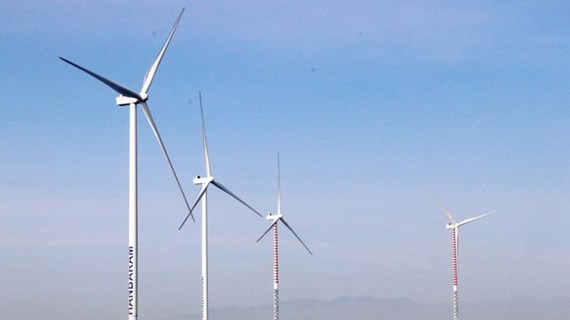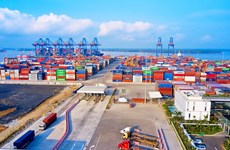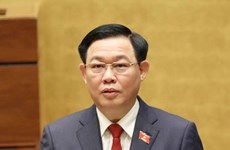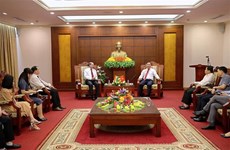Party chief’s China visit to boost stable, healthy ties
The forthcoming visit to China by Party leader Nguyen Phu Trong, the
first official visit to the country made by a Vietnamese Party General
Secretary since the 18th national congress of the Communist Party of
China, aims to build up momentum for the healthy development of
Vietnam-China relations, particularly in the context of the two
countries’ diplomatic ties entering their 65th year (January 18,
1950-2015).
Since the 1991 normalisation, the ties have grown fast and profound in all aspects with frequent meetings of high-ranking officials held and many cooperation agreements signed, enhancing mutual understanding and facilitating the long-term and result-oriented partnership.
Since the 1991 normalisation, the ties have grown fast and profound in all aspects with frequent meetings of high-ranking officials held and many cooperation agreements signed, enhancing mutual understanding and facilitating the long-term and result-oriented partnership.
The forthcoming visit to China by Party leader Nguyen Phu Trong, the
first official visit to the country made by a Vietnamese Party General
Secretary since the 18th national congress of the Communist Party of
China, aims to build up momentum for the healthy development of
Vietnam-China relations, particularly in the context of the two
countries’ diplomatic ties entering their 65th year (January 18,
1950-2015).
Since the 1991 normalisation, the ties have grown fast and profound in all aspects with frequent meetings of high-ranking officials held and many cooperation agreements signed, enhancing mutual understanding and facilitating the long-term and result-oriented partnership.
The sides have thus far organised ten ideology workshops between the two parties and seven conferences of the joint steering committee for bilateral cooperation, while the defence, security and national defence sectors have signed and implemented many cooperative agreements. Provinces of both countries have worked together in many fields, and various people-to-pepole exchanges held including 6 people’s forums and 14 youth friendship festivals.
During the last ten years, China has continually been Vietnam’s largest trade partner while Vietnam has become the second biggest ASEAN trade partner of China, after Indonesia. In 2014, the two-way trade revenue reached 58.87 billion USD. A total investment of 7.94 billion USD in 1,082 projects made China the ninth largest foreign investor in Vietnam by the end of last year.
A five-year economic-trade pact (2012-2016) was inked during the 2011 visit of the Vietnamese Party General Secretary. In 2013, when Chinese Prime Minister Li Keqiang made a working trip to Vietnam, the sides agreed to beef up economic-commercial engagement focusing on several key infrastructure and transport projects. They also set goals to bring bilateral trade revenue to 60 billion USD in 2015 and 100 billion USD in 2017.
Bilateral ties in education and tourism are growing, with around 13,500 Vietnamese students in China and 4,000 Chinese students in Vietnam. Some 1 million Vietnamese travel to China every year, while 1.94 million Chinese visited Vietnam in 2014 alone.
Regarding territory and border issues, the two countries have signed an agreement on basic principles for settling territory and border issues. So far, the two have signed a treaty on land border delimitation (in 1999), an agreement on the delimitation of the Tonkin Gulf (in 2000), another on fishery cooperation in the Tonkin Gulf (in 2000), and a protocol on fishery cooperation in the Tonkin Gulf (in 2004).
On the East Sea issue, the two countries have signed an agreement on basic principles guiding the settlement of sea-related issues. The ASEAN, of which Vietnam is a member, and China signed the Declaration on the Conduct of Parties in the East Sea (DOC) in 2002. The bloc is expeditiously working towards an early conclusion of the Code of Conduct in the East Sea (COC), with the first official consultation at Senior Official Meeting level held in September 2013.
However, complicated developments in the East Sea put considerable impacts on Vietnam-China cooperative ties in various fields and hindered the implementation of a number of exchange and cooperative programmes despite certain improvements in the bilateral relationship.
The visit of Party General Secretary Nguyen Phu Trong is hoped to strengthen the friendly and stable situation, facilitating the settlement of existing problems between the two countries.-VNA
Since the 1991 normalisation, the ties have grown fast and profound in all aspects with frequent meetings of high-ranking officials held and many cooperation agreements signed, enhancing mutual understanding and facilitating the long-term and result-oriented partnership.
The sides have thus far organised ten ideology workshops between the two parties and seven conferences of the joint steering committee for bilateral cooperation, while the defence, security and national defence sectors have signed and implemented many cooperative agreements. Provinces of both countries have worked together in many fields, and various people-to-pepole exchanges held including 6 people’s forums and 14 youth friendship festivals.
During the last ten years, China has continually been Vietnam’s largest trade partner while Vietnam has become the second biggest ASEAN trade partner of China, after Indonesia. In 2014, the two-way trade revenue reached 58.87 billion USD. A total investment of 7.94 billion USD in 1,082 projects made China the ninth largest foreign investor in Vietnam by the end of last year.
A five-year economic-trade pact (2012-2016) was inked during the 2011 visit of the Vietnamese Party General Secretary. In 2013, when Chinese Prime Minister Li Keqiang made a working trip to Vietnam, the sides agreed to beef up economic-commercial engagement focusing on several key infrastructure and transport projects. They also set goals to bring bilateral trade revenue to 60 billion USD in 2015 and 100 billion USD in 2017.
Bilateral ties in education and tourism are growing, with around 13,500 Vietnamese students in China and 4,000 Chinese students in Vietnam. Some 1 million Vietnamese travel to China every year, while 1.94 million Chinese visited Vietnam in 2014 alone.
Regarding territory and border issues, the two countries have signed an agreement on basic principles for settling territory and border issues. So far, the two have signed a treaty on land border delimitation (in 1999), an agreement on the delimitation of the Tonkin Gulf (in 2000), another on fishery cooperation in the Tonkin Gulf (in 2000), and a protocol on fishery cooperation in the Tonkin Gulf (in 2004).
On the East Sea issue, the two countries have signed an agreement on basic principles guiding the settlement of sea-related issues. The ASEAN, of which Vietnam is a member, and China signed the Declaration on the Conduct of Parties in the East Sea (DOC) in 2002. The bloc is expeditiously working towards an early conclusion of the Code of Conduct in the East Sea (COC), with the first official consultation at Senior Official Meeting level held in September 2013.
However, complicated developments in the East Sea put considerable impacts on Vietnam-China cooperative ties in various fields and hindered the implementation of a number of exchange and cooperative programmes despite certain improvements in the bilateral relationship.
The visit of Party General Secretary Nguyen Phu Trong is hoped to strengthen the friendly and stable situation, facilitating the settlement of existing problems between the two countries.-VNA













